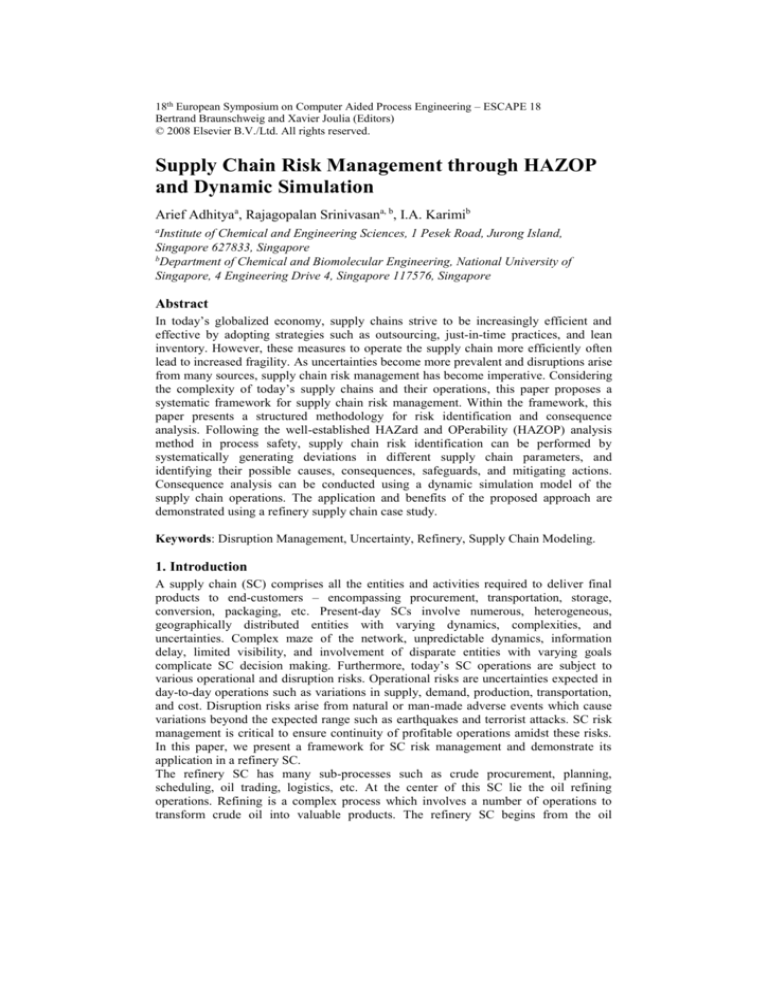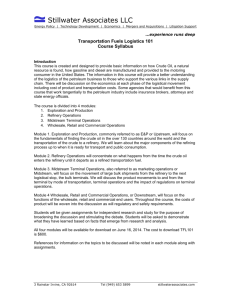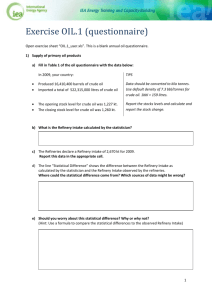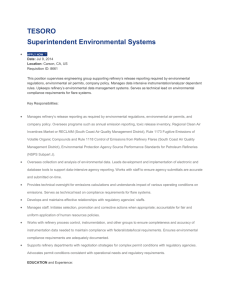
18th European Symposium on Computer Aided Process Engineering – ESCAPE 18
Bertrand Braunschweig and Xavier Joulia (Editors)
© 2008 Elsevier B.V./Ltd. All rights reserved.
Supply Chain Risk Management through HAZOP
and Dynamic Simulation
Arief Adhityaa, Rajagopalan Srinivasana, b, I.A. Karimib
a
Institute of Chemical and Engineering Sciences, 1 Pesek Road, Jurong Island,
Singapore 627833, Singapore
b
Department of Chemical and Biomolecular Engineering, National University of
Singapore, 4 Engineering Drive 4, Singapore 117576, Singapore
Abstract
In today’s globalized economy, supply chains strive to be increasingly efficient and
effective by adopting strategies such as outsourcing, just-in-time practices, and lean
inventory. However, these measures to operate the supply chain more efficiently often
lead to increased fragility. As uncertainties become more prevalent and disruptions arise
from many sources, supply chain risk management has become imperative. Considering
the complexity of today’s supply chains and their operations, this paper proposes a
systematic framework for supply chain risk management. Within the framework, this
paper presents a structured methodology for risk identification and consequence
analysis. Following the well-established HAZard and OPerability (HAZOP) analysis
method in process safety, supply chain risk identification can be performed by
systematically generating deviations in different supply chain parameters, and
identifying their possible causes, consequences, safeguards, and mitigating actions.
Consequence analysis can be conducted using a dynamic simulation model of the
supply chain operations. The application and benefits of the proposed approach are
demonstrated using a refinery supply chain case study.
Keywords: Disruption Management, Uncertainty, Refinery, Supply Chain Modeling.
1. Introduction
A supply chain (SC) comprises all the entities and activities required to deliver final
products to end-customers – encompassing procurement, transportation, storage,
conversion, packaging, etc. Present-day SCs involve numerous, heterogeneous,
geographically distributed entities with varying dynamics, complexities, and
uncertainties. Complex maze of the network, unpredictable dynamics, information
delay, limited visibility, and involvement of disparate entities with varying goals
complicate SC decision making. Furthermore, today’s SC operations are subject to
various operational and disruption risks. Operational risks are uncertainties expected in
day-to-day operations such as variations in supply, demand, production, transportation,
and cost. Disruption risks arise from natural or man-made adverse events which cause
variations beyond the expected range such as earthquakes and terrorist attacks. SC risk
management is critical to ensure continuity of profitable operations amidst these risks.
In this paper, we present a framework for SC risk management and demonstrate its
application in a refinery SC.
The refinery SC has many sub-processes such as crude procurement, planning,
scheduling, oil trading, logistics, etc. At the center of this SC lie the oil refining
operations. Refining is a complex process which involves a number of operations to
transform crude oil into valuable products. The refinery SC begins from the oil
2
Adhitya et al.
reservoirs, found most abundantly in the Middle East region, and tapped via both
ground fields and offshore platforms. Transportation of the crude to various processing
plants/refineries around the world is carried out mostly by large ships called Very Large
Crude Carriers (VLCCs) or pipelines. Even with extensive networks and carefully
planned schedules, transportation times are relatively long; it takes 4-6 weeks for a
VLCC carrying crude oil from the Middle East to reach refineries in Asia. Such long
periods make crude supplies easily susceptible to disruptions, leading to failure to meet
customers’ demands or a crude stock out. This is a critical problem as it would compel
unit shutdowns and result in large losses. A single crude mix allows numerous products
and their variants to be produced through a suitable alteration of processing conditions.
Accordingly, refineries must adapt their operations to the different crude batches to
maintain the required product specifications, which gives rise to differing operating
costs. Further, since crude oil prices, product demands and prices fluctuate highly,
optimization needs to be done frequently. Other key features of the refinery SC are large
inventories, need for safety-first, sensitivity to socio-political uncertainties,
environmental regulations, and extensive trading. Hence, there is clearly a need for risk
management in the refinery SC.
1.1. Literature Review
SC risk management is a growing research area. Chopra and Sodhi (2004) group SC
risks into eight categories (disruptions, delays, systems, forecast, intellectual property,
procurement, receivables, inventory, and capacity) and give general mitigating
strategies for each category. Kleindorfer and Van Wassenhove (2004) discuss two types
of risk management issues in global SCs: matching supply to demand and addressing
disruptions to SC activity. Mishra, et al. (2003) present an agent-based decision support
system to manage disruptions in a refinery SC. In the event of a disruption, agents
collaborate to identify a holistic rectification strategy using heuristic rules. Since there is
limited literature on structured and elaborate methodology for SC risk management, this
paper attempts to propose one such methodology.
2. Framework and Methodology for Supply Chain Risk Management
The proposed framework for SC risk management is illustrated in Figure 1 and
comprises the following steps:
1. Risk identification: The first step is to recognize uncertainties and risks faced by the
SC. With globalization and increased outsourcing practices, the number of parties
involved in the SC and the links connecting them have increased significantly.
Hence, some risks may not be obvious and it is important to have a structured
method for risk identification, as presented in Section 2.1.
2. Consequence analysis: Once the risks have been identified, their consequences have
to be analysed using an appropriate model of SC operations. The disruptions due to
one particular risk or a combination of risks can be simulated and propagated
through the SC model and the effects analysed. In a complex SC, there could be
important domino effects. These should be explicitly considered in the analysis.
Section 2.2 presents a dynamic simulation model of the integrated refinery SC which
enables such analysis.
3. Risk estimation: Risk is usually quantified in financial terms and/or ranked according
to some pre-defined criteria. The frequency or probability of each risk materializing
is estimated. The risk is quantified in two dimensions: its frequency/probability and
its severity/consequence, taking into account the effects of mitigating actions and
safeguards, if any.
Supply Chain Risk Management through HAZOP and Dynamic Simulation
Risk
identification
List of
detected
risks
Consequence
analysis
Risk
estimation
List of risks and
their estimates
List of risks, their
safeguards and
mitigating actions
Significant changes
such that risk study
is necessary
Risk
monitoring
List of risks
and their
effects
KPIs and
supply chain
changes
Risk
mitigation
3
Risk assessment
No
Supply chain
operation
Risk acceptable?
Yes
Figure 1. Proposed framework for SC risk management
4. Risk assessment: The risk management team decides whether the risk quantified in
the previous step is acceptable based on experience, industry standards, benchmarks,
or business targets. If not, additional mitigation actions or safeguards are required.
5. Risk mitigation: Mitigating actions and safeguards such as emergency procedures
and redundancies have to be developed for the risks, based on both the SC model and
inputs from the risk management team or relevant personnel. Two types of
mitigating action can be differentiated – preventive and responsive. Once the risks
have been deemed acceptable, SC operations proceed with the appropriate
safeguards and mitigating actions in place.
6. Risk monitoring: The SC structure and operation do not remain stationary but
changes regularly due to, for example, new suppliers, new regulations, new operating
conditions, new products, etc. The risk management team should continually monitor
the SC for new risks. The team might be required to start from step (1) to consider
the new risks arising from these changes.
2.1. Risk Identification through HAZOP
For risk identification, this paper proposes to employ the HAZard and OPerability
(HAZOP) analysis method from chemical process risk management. SC networks are in
many ways similar to chemical plants. Drawing from this analogy, we propose to
represent SC structure and operations using flow diagrams, equivalent to process flow
diagrams (PFDs). A simplified flow diagram of the refinery SC is shown in Figure 2.
Following the well-established HAZOP method, SC risk identification can be
performed by systematically generating deviations in different SC parameters, and
identifying their possible causes, consequences, safeguards, and mitigating actions. The
deviations are generated using a set of guidewords in combination with specific
parameters from the flow diagrams. Table 1 gives a non-exhaustive list of these
guidewords and parameters. The guideword “Low” can be combined with a flow to
result in, for example, the deviation “Low demand”. Possible causes and consequences
can be identified by tracing the flows in the diagram. Safeguards are any items or
procedures which help to protect against a particular deviation. It could protect against
the deviation before it occurs, i.e. reducing the frequency, or help to recover quickly and
minimize impact after it occurs, i.e. reducing the severity. An example of the former is
safety stock, which protects against demand uncertainty; an example of the latter is
insurance. Mitigating actions are additional items or procedures on top of any existing
safeguards which are deemed necessary to manage the deviation.
4
Adhitya et al.
Suppliers
1
2
3
4
3PLs
Shipper
1
2
Jetty
Procurement
Dept
Logistics
Dept
Storage Dept
Crude Tanks
Operations Dept
Refinery Process
CDU
Blend tanks
Storage Dept
Sales
Dept
Product Tanks
Refinery
Shipper
1
2
3PLs
Customers
1
2
Material Flow
Legend
3
4
Information Flow
Figure 2. Simplified refinery SC flow diagram
Table 1. Sample guidewords and parameters for HAZOP
Guidewords
No
High
Low
Early/late
Parameters
Material flow
Information flow
Finance flow
Meaning
None of the design intent is achieved
Quantitative increase in a parameter
Quantitative decrease in a parameter
The timing is different from the intention
Raw material, side product, energy, utility, etc
Order, quote, forecast, message, signal for action, etc
Cash, credit, share, receivables, pledge, contract, etc
Supply Chain Risk Management through HAZOP and Dynamic Simulation
5
2.2. Consequence Analysis through Dynamic Simulation
For consequence analysis, we have developed a dynamic simulation model of the
refinery SC, called Integrated Refinery In-Silico (IRIS) (Pitty et al., 2007). It is
implemented in Matlab/Simulink (MathWorks, 1996). Four types of entities are
incorporated in the model: external SC entities (e.g. suppliers), refinery functional
departments (e.g. procurement), refinery units (e.g. crude distillation), and refinery
economics. Some of these entities, such as the refinery units, operate continuously while
others embody discrete events such as arrival of a VLCC, delivery of products, etc.
Both are considered here using a unified discrete-time model. The model explicitly
considers the various SC activities such as crude oil supply and transportation, along
with intra-refinery SC activities such as procurement planning, scheduling, and
operations management. Stochastic variations in transportation, yields, prices, and
operational problems are considered. The economics of the refinery SC includes
consideration of different crude slates, product prices, operation costs, transportation,
etc. The impact of any disruptions or risks such as demand uncertainties on the profit
and customer satisfaction level of the refinery can be simulated through IRIS.
3. Case Study
This case study is based on the refinery SC flow diagram in Figure 2. We consider the
parameter “Crude arrival”, which is the material flow from the jetty to the refinery
crude tanks (marked by a star in Figure 2), and the guideword “No” to derive the
deviation “No crude arrival”. To study the possible causes of this deviation, we trace
backward from the crude arrival flow and find the jetty, shipper, and supplier entities.
No crude arrival could be caused by unavailability or disruption to any of these entities,
e.g. jetty closure, shipper unreliability, or supplier stock-out. The possible consequences
can be examined by tracing forward from the crude arrival flow, from which we find the
crude tanks, processing units, product tanks, shipper, and customers. Thus, the possible
consequences of no crude arrival are low inventory in the crude tanks, possible out-ofcrude situation which leads to operation being disrupted, low inventory in the storage
tanks, low product shipment to customers, and unfulfilled demand. Safeguards for this
deviation are required to cover for the crude which is not arriving. These could be in the
form of crude safety stock or emergency crude procurement. Since shipper unreliability
is one possible cause, a suitable mitigating action could be to consider engaging a more
reliable shipper. Other mitigating actions include establishing better communication and
transparency with suppliers and shippers for timely notice of any delay, and
rescheduling to avoid shutdown by reducing throughput until the crude arrives. These
HAZOP results are summarized in Table 2.
Consequence analysis of no crude arrival due to delay in transportation is performed
using IRIS simulations. In this case, the refinery would like to evaluate the mitigating
action of engaging a more reliable shipper. The existing shipper has a 10% probability
of late crude delivery while the new shipper is more reliable with a 5% probability of
delay. However, the new shipper on average costs $30million more than the existing
one. The refinery also considers having a safeguard in the form of safety stock. Hence,
four cases are evaluated: with and without safety stock for each shipper option. The
resulting profit and customer satisfaction from these cases are shown in Table 3. Safety
stock can increase customer satisfaction to 95% despite low existing shipper reliability.
However, profit suffers a lot from low shipper reliability. This is because of high
shutdown costs. Demand backlog can be satisfied in the next immediate cycle, hence
customer satisfaction does not suffer much from shutdown. Safety stock cannot make
6
Adhitya et al.
up for poor performance of shipper. In both cases (with and without safety stock), the
new shipper increases the profit by more than $50million. Since the increase in profit is
more than the increase in cost, it is recommended to switch to the new shipper. Further,
safety stock is also recommended as it increases both customer satisfaction and profit.
4. Concluding Remarks
Risk management is critical for today’s SCs. In this paper, we propose a systematic
framework for SC risk management and structured methodology for risk identification
and consequence analysis, demonstrated in a refinery SC. The proposed HAZOP
method for risk identification has two notable advantages. It is systematic, because the
deviations studied are generated using pre-defined guidewords and pertinent system
parameters, as opposed to ad-hoc scenario analysis. It is also complete, because it is
structured around a representation of the whole process in the form of flow diagrams, as
opposed to other methods with limited scope such as checklist. Consequence analysis is
performed through IRIS, a dynamic simulation model of the refinery SC. Risk
probability estimation, cost-benefit analysis and optimization of risk management
strategies are the direction of our current work.
References
S., Chopra and M. S. Sodhi, 2004, Managing Risk to Avoid Supply Chain Breakdown, MIT Sloan
Management Review, 46, 1, 53-61.
P. R. Kleindorfer and L. N. Van Wassenhove, 2004, Managing Risk in Global Supply Chains, In
H. Gatigon and J. Kimberly (eds.), The Alliance on Globalization, Cambridge University
Press, Chapter 12.
MathWorks, 1996, Using Simulink: Version 2.
M. Mishra, R. Srinivasan, and I. A. Karimi, 2003, Managing disruptions in refinery supply chain
using an agent-based decision support system, Presented at the AIChE annual meeting, San
Francisco, CA, Nov 16-21.
S. S. Pitty, W. Li, A. Adhitya, R. Srinivasan, and I. A. Karimi, 2007, Decision Support for
Integrated Refinery Supply Chains. 1. Dynamic Simulation, Computers and Chemical
Engineering (In Press).
Table 2. HAZOP results for crude arrival delay
Deviation
No crude
arrival
Causes
Consequences
Safeguards
Jetty
unavailability;
Shipper
disruption;
Supplier stockout
Low stock, outof-crude;
Operation
disrupted;
Demand
unfulfilled
Safety
stock;
Emergency
suppliers
Mitigating
Actions
More reliable
shipper;
Frequent check
with supplier
/logistics;
Rescheduling
Table 3. Consequence analysis results for the risk of crude arrival delay
Safety Stock
Yes
No
Average Customer
Satisfaction (%)
Shipper
Existing
New
95
98
91
95
Average Profit ($, million)
Shipper
Existing
New
38
93
27
83







